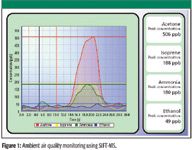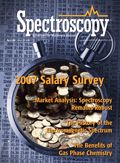SIFT-MS: Gas-Phase Chemistry - MS with a Difference
Guest author Rebecca Bain of SYFT Technologies discusses a new technique for VOC analysis. SIFT-MS can be used successfully in a wide variety of applications, including medical research, shipping container air analysis, laboratory analysis, and air-quality monitoring.

If real-time analysis of volatile organic compounds (VOCs) is important to you, selected ionflow tube mass spectrometry (SIFT-MS) might be the technique you are looking for. Utilizing chemical ionization and dual quadrupole mass selection, SIFT-MS eliminates gas chromatography (GC) columns and sample preparation, creating a new dimension in rapid laboratory-grade VOC analysis.
The SIFT-MS technique uses a soft chemical ionization reaction between a single selected reagent ion and the gas-phase sample analytes that produce fixed chemical reactions. By using gas-phase ion chemistry and tightly controlled reaction conditions, SIFT-MS provides instantaneous quantification of target analyte species.
SIFT-MS uses three reagent ions (H3O+ , O2+ , and NO+ ) to chemically ionize VOCs in air samples. The process forms product ions, which are indicative of the VOCs present in a sample. Product ions are detected over a full mass range of 10–300 atomic mass units (amu). Most VOCs react with one or more of the three reagent ions, making them suitable for SIFT-MS analysis. In addition, SIFT-MS can be used to quantify certain inorganic gases, such as ammonia, nitrogen dioxide, and hydrogen sulfide.
SIFT-MS Capabilities
Gas-Phase Samples
In SIFT-MS, the whole air sample is introduced directly into the flow tube reaction region for analysis. Suitable sample presentation methods include whole air, breath, Tedlar bags, canisters, and preconcentrated media such as sorbent tubes or solid-phase microextraction fibers.
Instantaneous Quantification
SIFT-MS analysis provides a real-time response of 250 ms between sample introduction and compound quantification. The instantaneous nature of SIFT-MS analysis allows the study of dynamic samples such as flavor release, which precludes complex sample preparation procedures.
Sensitivity
SIFT-MS provides absolute quantification of analyte concentrations (not just the relative concentrations) in the parts-per-trillion (by volume) range. This sensitivity, combined with instantaneous analysis, makes SIFT-MS extremely suitable for addressing food and flavor applications as well as breath-based medical diagnostics.
Direct Analysis of High-Moisture Samples
Usually, analyzing moist gas-phase samples with traditional techniques requires that the sample is dried before analysis can commence. SIFT-MS is unique in allowing accurate quantification of moist samples, critical for the analysis of breath and other humid sample matrixes.
Discriminate Isobaric Compounds and Isomers
Utilizing three reagent ions provides SIFT-MS with a distinct advantage over comparative single-precursor techniques such as proton transfer reaction MS and atmospheric pressure chemical ionization MS. By switching between reagent ions, SIFT-MS can differentiate compounds that share the same mass (isobaric) and compounds that share the same mass and chemical formula (isomers).
For example, proton transfer reaction MS, which uses H3O+ as its sole reagent ion, cannot discriminate the common compounds acetaldehyde and ethylene oxide, because they both produce products at mass 45. However, by using NO+ as the reagent ion, SIFT-MS discriminates these compounds because the acetaldehyde product is at mass 43 and the ethylene oxide product is at mass 74.
From one integrated scan process, SIFT-MS analysis provides clear, realtime discrimination of individual isobaric compounds and many isomers.
How SIFT-MS Works
The ability of SIFT-MS to quantify absolute analyte concentrations instantaneously in gas-phase samples is the result of four factors:
- Introducing a selected single thermalized reagent ion stream into the reaction chamber (the flow tube).
- A thorough understanding of the physical dynamics of the flow tube, including the reaction time.
- A comprehensive knowledge of the ion chemistry occurring in the flow tube for each analyte.
- Precise control of flow tube conditions, such as sample and gas flows, temperature, and vacuum conditions.
The SIFT-MS process can be divided into five main steps:
- Generation of ions: These SIFT-MS instruments use either a microwave discharge or radio frequency (RF) source to generate positive ions.
- Ion selection: The ions enter an upstream chamber, where a quadrupole mass filter removes all but the selected reagent ions. Generally, H3O+ , NO+ , and O2+ are selected as reagent ions.
- Sample introduction and reaction: The reagent ions pass through a venturi to a reaction chamber — the flow tube — where they react with sample, which enters the flow tube at a precisely controlled rate.
- Selection of reaction products: The reaction products enter a downstream chamber where they are filtered by a second quadrupole mass filter.
- Detection: A particle multiplier detects and counts the selected products. SIFT-MS uses a database to identify analytes. This database holds information on how rapidly an analyte reacts with the reagent ion (the "rate coefficient" for the reaction), the products of the reaction, and their relative abundances. Interpretation of detector product-ion intensity across the mass range provides identification of the sample analytes.
Soft Chemical Ionization
As with all types of MS, SIFT-MS uses ionization in the analysis process. But unlike many comparative forms of MS, such as GC–MS, SIFT-MS uses soft chemical ionization.
Typical reactions of the three SIFT-MS reagent ions are as follows:

SIFT-MS minimizes the fragmentation issues associated with higher energy ionization (such as electron impact ionizatio). Fragmentation occurs when energetic ionization processes break apart the compounds that are being analyzed. These fragments lead to complicated mass spectra, which make costly and time-consuming chromatographic separation necessary.
In contrast to hard ionization methods, the soft chemical ionization process used by SIFT-MS produces a significantly simpler mass spectrum, minimizing interference issues between compounds without chromatographic columns.
SIFT-MS Applications
The ability to process headspace and humid samples creates new opportunities for a wide variety of existing and emerging applications.
Medical Research
Bacterial bloodstream infection: Through analysis of blood headspace, bacterial culture times can be reduced significantly, thereby decreasing diagnosis times and providing improved patient outcomes and the potential for a reduction in healthcare-associated costs.
Breath analysis: Medical research already has established that many conditions such as cancer, infections, and diabetes all create signature patterns of VOCs on a patient's breath. The ability to identify these patterns using SIFT-MS instruments has huge potential for noninvasive screening and early diagnosis of disease.
Shipping Container Air Analysis
OSH compliance: Workers inspecting or unloading shipping containers are routinely exposed to hazardous concentrations of fumigants or other toxic compounds. SIFT-MS instruments provide fast and accurate identification and measurement of these compounds, facilitating worker safety. These SIFT-MS instruments can detect a suite of chemically diverse compounds. No other technology platform exists that provides realtime quantification with no sample preparation and such user-friendly interfaces.

Figure 1
Contraband: SIFT-MS can detect the volatile signatures of illegal contraband or goods of interest to customs and government entities.
Laboratory Analysis
Food and flavor: Due to exceptional sensitivity and the unique multireagent ion approach, SIFT-MS provides an ideal tool for analysis and true quantification of flavor compounds, including difficult-to-detect compounds such as vanillin.
Environmental: The technique also rapidly analyzes whole-air samples for a range of air-quality monitoring applications, including exhaust emissions, sulfur-containing compounds, and other pollutants.
Breath Specific Example
For centuries, physicians have recognized that people who have kidney failure have a distinctive breath odor, described as ammonia-like and termed "uremic fetor." This is thought to be due to the accumulation in the body of waste products that normally are excreted by the kidneys. Currently, diagnosis of kidney failure is invasive and might not be timely enough to allow early intervention and treatment. There would be great advantages to having a fast, noninvasive method able to detect early changes in kidney function.
SIFT-MS breath analysis in patients with kidney failure is allowing physicians and scientists to detect subtle changes in kidney function. Patients with kidney failure are being studied before, during, and after dialysis, following kidney transplantation, and during episodes of acute renal failure. Breath test results are being correlated with the results from conventional blood test measurements of kidney function and with renal biopsy results. Measurement of breath VOCs might provide a means to measure the adequacy of dialysis treatments, whether a patient is rejecting a transplanted kidney, or if a patient is suffering the early stages of acute renal failure.
Summary
Using chemical ionization and dual quadrupole mass selection, SIFT-MS eliminates GC-style columns and sample preparation, creating a new dimension in rapid, laboratory-grade VOC analysis. Designed to fit seamlessly into the most demanding environmental, medical, food, and research laboratories, SIFT-MS is already proving itself in the world of VOC analysis.
Rebecca Bain is with SYFT Technologies.
Emil W. Ciurczak is chief technical officer at Cadrai Technology Group (Bel Air, MD). He can be reached via e-mail at: emil@ciurczak.com

Emil W. Ciurczak
A Proposal for the Origin of the Near-Ubiquitous Fluorescence in Raman Spectra
February 14th 2025In this column, I describe what I believe may be the origin of this fluorescence emission and support my conjecture with some measurements of polycyclic aromatic hydrocarbons (PAHs). Understanding the origin of these interfering backgrounds may enable you to design experiments with less interference, avoid the laser illuminations that make things worse, or both.
Raman Microscopy for Characterizing Defects in SiC
January 2nd 2025Because there is a different Raman signature for each of the polymorphs as well as the contaminants, Raman microscopy is an ideal tool for analyzing the structure of these materials as well as identifying possible contaminants that would also interfere with performance.
